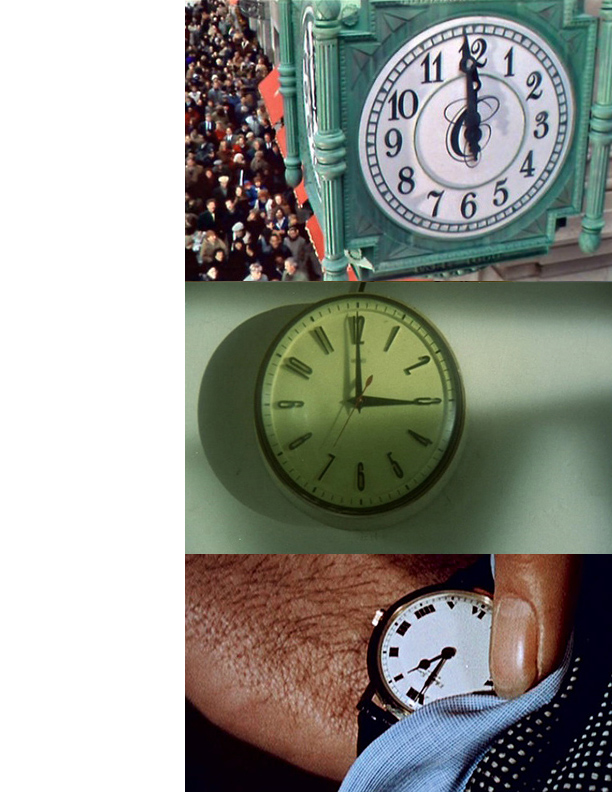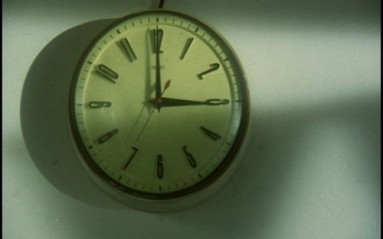Notes on Chritian Marclay’s The Clock, a 24-hour compilation of movie scenes dealing with the real time
1. Christian Marclay's The Clock is an epic notation of time. I watched four (1/6) of the 24 hours of The Clock. I note this because real time is both central and minor to this allegorical film on time: The point at which you start watching it and the point at which you stop is almost inconsequential. The Clock doesn’t have an official beginning or end. You can enter and exit it at any point — are expected to — just like you can start and stop a day whenever you want. Also, despite the constant presence of clocks in the film tracking every minute, I repeatedly checked my watch for the time.
2. While The Clock is itself a clock that goes around the clock — that goes through every hour of the day — it is not linear. The film time jumps and shifts tenses every minute. Chronology is scrambled like code. Time is a Matryoshka doll: time inside of time inside of time. The Clock uses time to make and break time.
3. If the history of cinema has been modeled on recall, part of the thrill of The Clock is seeing again what we’ve seen before. Geoffrey O’Brien in The Phantom Empire: “For the first twenty years [of cinema] it was almost enough to just show things. Robbers. Stenographers. Naughty children. Fires. Coronations. Battleships. More fires. People talking into telephones. Cars moving at high speed through narrow streets. The spectator wallowed in the visible.” Recognition is tied to the star system, a field of repetition-recognition, which means cinema is also, as we know, about remembering, which results in a privileging of who and what is memorable, who and what is worth looking at.
4. The first film with a running time of 24 hours was Douglas Gordon’s 1993 24 Hour Psycho, which slows Hitchcock’s 1960 Psycho down to two frames a second, rather than the usual 24. The film explores themes such as “recognition and repetition, time and memory, complicity and duplicity, authorship and authenticity, darkness and light.”
5. What do we turn to cinema for? What do we use cinema to turn away from?
6. Alejandro Zambra, Ways of Going Home: “I was going to be a memory when I grew up.”
7. Paul Newman and Robert Redford appear as young and as old in The Clock. Neither ever gained weight. Their bodies stayed the same their entire lives. This removes some of the shock of time. I have always been fascinated by the things that stay the same and the things that change dramatically.
8. When it comes to the screen, for whom is it more difficult to age? The viewer or the star? Does the viewer escape or face aging through the actor?
9. The Clock goes in and out of time. Geoffrey O’Brien: “Events could be dates by which actors were still alive, or by how many wrinkles they had acquired. The unnatural difference here was that the process could be reversed, the past restored.”
10. When you look closely at some people’s faces, you realize they are not beautiful. When you look closely at other people’s faces, you realize that they are. Real beauty always requires closer inspection. Looking before seeing.
11. Around the second hour of The Clock, the young John Cusack appears in the hospital scene of Stephen Frears’ The Grifters. I think: I will never get over this pale-moon face, which is not even this face anymore.
12. In A Thousand Plateaus Deleuze and Guattari write: “The hands of a clock foreshadow something.” Because of cinema, the home of the face, the clock and the face merge. The hands on the face of a clock. The clock on the hours of a face. The clock is a destiny in the same way that a face is. Both Bergman’s and Fellini’s films are one long clock. Fellini loves the sound of wind howling, which is the sound of time passing. Loves it the way Bergman loves a ticking clock. It’s the time we’re up against, and in, and out of. A camera is a hole that captures a face. “This is the face as seen from the front, by a subject who does not so much see as get snapped up by black holes. This is the figure of destiny... its only function is to have an anticipatory temporal value.” For D&G the face has a history and a politic that is universal, whereas George Orwell famously observed that the arc of a face — the direction a face takes over the course of time — is not commensurate with organic (biological) destiny, but with a kind of moral trajectory. At fifty everyone has the face they deserve. What might be called a chronology of ethics, or ethical chronology, is at work in Orwell’s conception of the face. How one lives, for Orwell, is also how one deserves to age. A face, and presumably its beauty, is something that you get to keep — or don’t — depending on how you’ve lived.
13. In Choking On Marlon Brando, the film critic Antonia Quirke writes, “Faces are like poems. The longer they take to puzzle out, the better.” But in mass media, the face is the marketplace of the face. Beauty is an a priori commodity and should therefore make its case immediately to the most amount of people. No one wants to “puzzle” anything out when it comes to the face, which is supposed to be explicit, not implicit. Beauty is coded and its codes should be intelligible and accessible. Plastic surgery is one way to assign codes to a face, converting F.T. Marinetti’s “the beauty of speed” to the speed of beauty. The face is — reflects — what already is, which is what D&G mean when they state that the face is a redundancy in Western capitalist culture.
14. Fame is said to have a price, but fame is all price. The cost of human cost.
15. In The Clock, cinema is the face of time and time is the face of cinema.
16. Where do we hide our insides and where do we show them? Life or screen?
17. Agnès Varda 1981 film Documenteur: “It’s often said when you’re up against the wall, show your insides, your real face. As if usually you had a phony face and hidden insides. A spare head to put up a false front, a face for all occasions. Faces are all I see. They seem real, more real than conversations.”
18. The Clock makes a tautology of everything, not just time. American culture has always been tautology. Everything recurs. We celebrate and mourn—mourn as a form of celebration—over and over.
19. Memento mori: “Remember your mortality,” “Remember you must die,” or “Remember you will die.”
20. The minute I note the absence of Wong Kar-wai’s
films on time in The Clock, particularly the green-tinted clock in Days of Being Wild, the very clock image I’m thinking of appears and designates the third hour of Marclay’s film.21. In my essay “One-Minute Lovers” I splice a romantic experience I had with Wong Kar-wai’s time-bound lovers in Days of Being Wild:
He tells her: Look at my watch.
He is standing so close to her.
She says: Why should I?
At the party up in the mountains, out of sheer frustration I took your watch and put it on my wrist and you took my watch and put it on yours. All we could do was wear each other’s time. You were so callous that night. You actually looked pissed off when I walked in. It was late and I showed up with another man. At some point, you asked if you could try on my watch. Actually, no one asked. It was more like we both just suggested it at the exact same time and all of the sudden we were both taking our watches (not our clothes) off and putting each other’s watches on. Why? To see how they would look? A watch is a weird thing to borrow and time is a weird thing to trade. But that’s what we did: we handed each other’s watches over to one another and wore each other’s time in front of everyone like wedding bands. Even though we weren’t together. Even though we weren’t even talking.
She says: Time’s up. What now?
He asks: What’s today’s date?
She says: The 16th.
He says: Yeah, April 16th, 1960. One minute before 3. We were here together. I’ll always remember that minute because of you. From now on, we’re one-minute friends. It’s a fact. You can’t deny it. It’s already happened.
22. Why is TV time, which shows up sporadically, spliced with cinematic time in The Clock? Is TV time brought in to fill in the gaps in time that can’t be located in cinema? Not a break from our lives, the way cinema is a break, but a continuousness.
23. Cinema itself is a zone that doubles for itself. Folding you in the fold. Douglas Gordon describes 24 Hour Psycho as a work of abduction, not simply appropriation. The trope of time is the perfect model for apophenia. Apophenia, adjacent to schizophrenia and psychosis, is “the experience of seeing meaningful patterns or connections in random or meaningless data.” Freud says obsessional neurotics zoom in on everything, turning everything around them into a signifying closeup full of meaning. One of the features of the uncanny is the double. In Marclay’s film, time is an interminable double (return of the repressed) that functions as repetition-compulsion and repetition-recognition. Repetition itself can create mesmerism — the inception of the zone.
Freud: “The self may thus be duplicated, divided and interchanged. There is the constant recurrence of the same thing, the repetition of the same features, the same characters, the same destinies, the same misdeeds, even the same names, through successive generations.”
24. Miguel Gomes takes the title of his 2012 film Tabu from F. W. Murnau’s 1931 film Tabu: A Story of The South Seas: “I have the sensation that when I’m making films, there is the memory of other films, but in a very diffuse way, not a conscious way.” I have the sensation that one time is the memory of another time.


